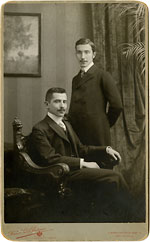Of Music and Men
Austrian writer Stefan Zweig created one of the world’s greatest collections of autographed music manuscripts, with Nazis at his heels By Stephen Maughan
Austrian writer Stefan Zweig was wildly proclaimed as one of the most talented writers of the early twentieth century, publishing a number of successful biographies, short stories, and novels, including the breathtaking Beware of Pity and the psychological thriller Letter from an Unknown Woman (which was turned into a celebrated Hollywood classic by director Max Ophüls in 1948). Zweig’s books were translated into 30 languages. Literary critic Nicholas Lezard of the Guardian newspaper once described him as “One of the masters, and I mean he’s up there with Maupassant, Chekhov, James, Poe or indeed anyone you care to name.”
Today, however, his popularity is on the wane, and only the few who read his work may know that he had a deep love of music, or that he and the composer Richard Strauss defied Adolf Hitler in 1935. Zweig himself owned a remarkable collection of 4,000 musical and literary autographed manuscripts, now held by the British Library in London.
Zweig began collecting at the age of fifteen, when be bought whatever manuscripts he could afford, yet as the years progressed and his literary success increased, he was able to pick and choose from the likes of celebrated composers such as Mozart, Chopin, and Schubert. He also collected literary manuscripts from writers he admired including Goethe, Shelley, and Fontaine, as well as those of his contemporaries, such as the poet Rainer Maria Rilke and the author Herman Hesse, who donated their own works to him.
Still, while his literary collection is fascinating, it is not surprising that a writer should have collected them. What has interested both scholars and those with even a passing interest in classical music, is Zweig’s deeply impressive music manuscript collection containing the very best work of the very best composers. The classical music writer Oliver Neighbour (who was superintendent of the Music Room of the BL from 1977 to 1987) acknowledged the collection’s distinction in Musical Times. He wrote, “During the last four decades of his collecting, he (Zweig) searched not only for the characteristic, but for works that stood among the highest achievements by their authors.” Mozart in particular was a lifelong fascination for Zweig, and the Zweig collection includes Mozart’s compositions from 1784 until his death in 1791, his marriage contract, five letters, and eleven musical autographs, such as Das Veilchen (Mozart’s only Goethe setting). Wagner was another Zweig favorite, and the library holds a range of material from the 1830s and 1840s featuring König Enzio, Rule Britannia, and Die hohe Braut. Also in the collection are ten classic Beethoven pieces, including The Ruins of Athens, and six Schubert works, with the exceptional An die Musik as a highlight. Other renowned musicians to be found in the collection include Schütz, Bach, Haydn, Chopin, Mahler, and Debussy.
There is one composition at the British Library that Zweig wrote himself. His libretto for Strauss’ Die Schweigsame Frau (The Silent Woman) had its world première in Dresden in June 1935, two years into the Nazi takeover. The concert was allowed despite the fact that Zweig was a Jew and a committed pacifist. Neither Zweig, nor Hitler (a music lover) attended, and the opera was banned after four performances. Soon afterwards Zweig fled to England, and Strauss’ comfortable position as president of the Reich’s Music Chamber was ruined.
The circumstances behind the collaboration between Zweig and Strauss is fascinating, the pair perhaps would have been natural friends and companions if it were not for the difficult period in German history they found themselves sharing. Zweig had long admired Strauss from a distance, and Strauss had been looking for a writer since the death of his longtime partner Hugo Von Hofmannsthal in 1929. Zweig and Strauss finally met at a theatre performance of Ben Jonson’s The Silent Woman in 1931 and agreed to collaborate on an operatic adaptation. By the time Zweig sent his text to Strauss in January 1933, Hitler was just two weeks from power.








